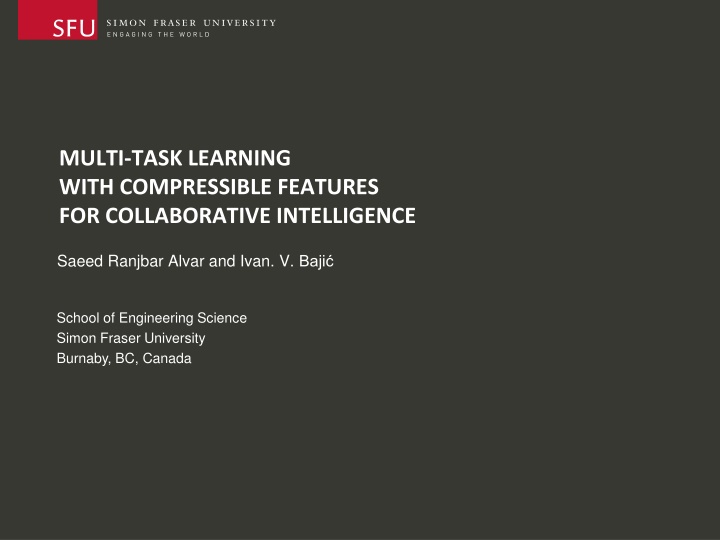
Collaborative Intelligence and Deep Feature Compression in Multi-Task Learning
Explore the intersection of collaborative intelligence and deep feature compression in multi-task learning models. Discover innovative approaches to enhance efficiency and performance in tasks such as semantic segmentation, disparity map estimation, and input reconstruction. Learn about deep feature compressibility loss functions and the application of Q-Layer techniques for deep feature compression.
Download Presentation

Please find below an Image/Link to download the presentation.
The content on the website is provided AS IS for your information and personal use only. It may not be sold, licensed, or shared on other websites without obtaining consent from the author. If you encounter any issues during the download, it is possible that the publisher has removed the file from their server.
You are allowed to download the files provided on this website for personal or commercial use, subject to the condition that they are used lawfully. All files are the property of their respective owners.
The content on the website is provided AS IS for your information and personal use only. It may not be sold, licensed, or shared on other websites without obtaining consent from the author.
E N D
Presentation Transcript
MULTI-TASK LEARNING WITH COMPRESSIBLE FEATURES FOR COLLABORATIVE INTELLIGENCE Saeed Ranjbar Alvar and Ivan. V. Baji School of Engineering Science Simon Fraser University Burnaby, BC, Canada
COLLABORATIVE INTELLIGENCE Mobile Only Cloud Only Intelligence Collaborative Y. Kang, J. Hauswaldand C. Gao, A. Rovinski, T. Mudge, J. Mars, and L. Tang, Neurosurgeon: Collaborative intelligence between the cloud and mobile edge, SIGARCH Comput. Archit. News, vol. 45, no.1, pp. 615 629, Apr. 2017 multimedia laboratory 2
MULTI-TASK MODEL FOR COLLABORATIVE INTELLIGENCE Encoder part on the mobile ResNet34 Inference tasks in the cloud 1. semantic segmentation 2. disparity map estimation 3. input reconstruction Model 1, Model 2 and Model 3: convolutional and transpose convolutional Multi-task model for collaborative intelligence multimedia laboratory 3
DEEP FEATURE COMPRESSION Q-Layer: During the testing: uniform n-bit min-max quantization During the training: uniform noise Quantized feature tensor tiled image Tiled image is coded: Lossless codec (PNG) Lossy codec (JPG) An example of the tiled quantized deep feature tensor (enhanced for better visualization) Deep feature compression module multimedia laboratory 4
DEEP FEATURE COMPRESSIBILITY LOSS (1) Loss functions for the three tasks: semantic segmentation: cross-entropy loss disparity map estimation: Mean Squared Error (MSE) loss input reconstruction: Mean Absolute Error (MAE) loss Feature compressibility loss input image ? encoder model ? deep feature tensor: ? ? ? ? (height, width, channels) ? = ? ? ;? loss function ??= ? ? related to the bitrate required for ? ?? is used as one of the loss functions differentiable with respect to ? almost everywhere. multimedia laboratory 5
DEEP FEATURE COMPRESSIBILITY LOSS (2) Entropy is not differentiable cannot be used in training ?-domain analysis: a bit rate-related quantity fraction of non-zero DCT coefficients (?) spatial prediction + ?1-norm of the DCT coefficients of the residual Differential Pulse Code Modulation (DPCM) along the rows and columns Let ?? be the ?-th channel of tensor ? Then horizontal and vertical differencing of ?? multimedia laboratory 6
DEEP FEATURE COMPRESSIBILITY LOSS (3) Spatial prediction residuals DCT of the prediction residual signal: ??and ??: the DCT matrices for row and column transforms feature compressibility loss: ?1-norm of the transformed prediction residual, averaged over the whole feature tensor the derivative of the absolute value at 0 is set to 1 multimedia laboratory 7
MULTI-TASK LEARNING LOSS End-to-end training for the multi-task model A single loss function capturing all task-specific losses three actual tasks one loss term related to the compressibility of deep features Overall multi-task loss: a linear combination of task-specific losses Following [10]: classification-type tasks regression-type tasks a trainable weight and a correction term for each loss [10] A. Kendall, Y. Gal, and R. Cipolla, Multi-task learning using uncertainty to weigh losses for scene geometry and semantics, in Proc. IEEE CVPR 18, 2018, pp. 7482 7491 multimedia laboratory 8
EXPERIMENTAL RESULTS (1) Cityscapes dataset 2,975 training images semantic segmentation and disparity map labels available for each image testing on 500 validation images resizing images to 512 256 Pytorch 250 epochs Adam optimizer polynomial decay applied to the initial learning rate of 10 3 multimedia laboratory 9
EXPERIMENTAL RESULTS (2) Two encoder networks: Encoder1: entire ResNet-34 (excluding the top classification layer), 8 16 512 feature tensors Encoder2: ResNet-34 with the last convolutional block excluded (also excluding the top classification layer) 16 32 256 Metrics for evaluation: Mean Intersection over Union (IoU) for segmentation Inverse Root Mean Square Error (IRMSE) for disparity estimation Peak Signal to Noise Ratio (PSNR) for input reconstruction Bits Per Feature Element (BPFE) Training without the proposed loss vs Training loss including the proposed loss multimedia laboratory 10
EXPERIMENTAL RESULTS (3) Encoder1 Encoder2 multimedia laboratory 11
EXPERIMENTAL RESULTS (4) Encoder1 Encoder2 multimedia laboratory 12
EXPERIMENTAL RESULTS (5) Encoder1 Encoder2 multimedia laboratory 13
EXPERIMENTAL RESULTS (6) to summarize the differences between performance curves: Bjontegaard delta (BD) approach average bit rate saving for the same performance metric value negative numbers = bitrate reduction The average bitrate reduction over test images of the proposed method compared to the benchmark multimedia laboratory 14
Code Code, weights and the results are available at: https://github.com/saeedranjbar12/mtlcfci multimedia laboratory 15
Any Questions? multimedia laboratory 16















